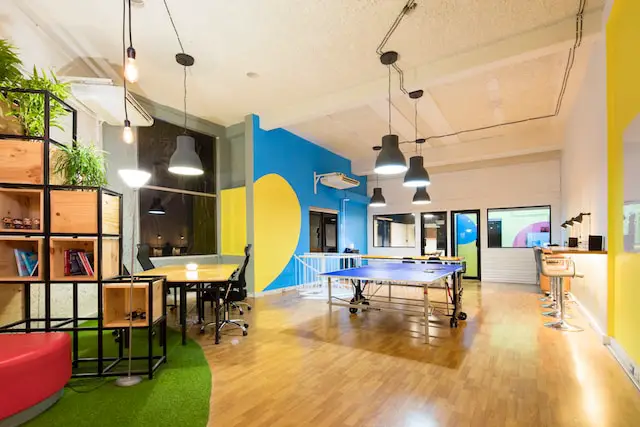Are you feeling overwhelmed by clutter in your home office? Has the workspace been overrun with piles of papers, boxes of supplies, and knick-knacks that make it hard to focus on what matters most: your work? It doesn’t have to be this way.
With a few simple changes and some strategic organizing tips, you can enable yourself to create more space in your office so that you can maximize productivity and get back to peak performance. In this blog post, we show you how – read on!
Add More Storage Space
The first step towards decluttering your office is to add more storage space. This doesn’t necessarily mean buying new furniture – many space-saving storage solutions can be utilized. For instance, second hand filing cabinets in good condition can be found at a fraction of the cost of brand-new ones.
Utilizing vertical space is also key – consider installing shelves or utilizing wall-mounted storage options to free up valuable desk and floor space. This not only helps to keep things organized and easily accessible but also creates a more visually appealing and spacious environment.
Declutter Your Workspace
Next, focus on decluttering your workspace. This involves discarding, recycling, or donating redundant items, broken, or no longer required. Keep only the essentials on your desk that you use daily for your work, such as your laptop, a notebook, and a pen. Store less frequently used items, like staplers and tape dispensers, in drawers or storage boxes.
Adopt a minimalist approach to reduce visual clutter, which can improve focus and productivity. A clutter-free desk not only looks appealing but also allows for smoother workflow and more efficient use of space. Decluttering is an ongoing process, not a one-time event. Set regular intervals to reassess and eliminate unnecessary items to maintain a tidy workspace.
Strategic Furniture Arrangement
Strategically arranging your office furniture can significantly enhance the sense of space and facilitate easier movement. Begin by placing your desk in a position that takes advantage of natural light, preferably near a window. This not only reduces reliance on artificial lighting but also creates a more stimulating and productive work environment.
Next, consider the placement of your storage units. If possible, position them close to your work area for easy accessibility, but without obstructing pathways. Tall furniture pieces, like bookcases or filing cabinets, should ideally be placed against the wall to maximize open floor space. Remember, the key to a well-arranged office is balance — creating a room that feels spacious and organized while ensuring all elements serve a functional purpose.
Embracing Multi-Functional Furniture
Invest in multi-functional furniture to maximize your office space efficiently. These are pieces that serve multiple purposes, thereby reducing the need for separate items. For instance, a desk with built-in drawers eliminates the need for a separate filing cabinet. A wall-mounted fold-down table can serve as a workspace when needed and folded up to free space when not in use.
Similarly, consider a shelving unit with a built-in desk, which combines storage and workspace into one efficient piece. Multi-functional furniture not only optimizes your office space but also adds versatility and convenience.
Employee Input and Collaboration
Inviting employee input and fostering collaboration is a powerful strategy for creating a highly functional and enjoyable workspace. Your colleagues can provide valuable insights into what works and what doesn’t within the current office space layout. Moreover, they may suggest innovative solutions or improvements that hadn’t previously been considered.
To encourage collaboration, you might implement a suggestion box, hold brainstorming sessions, or even create a workspace committee. Such collaborative efforts often lead to a sense of ownership among employees, enhancing their productivity and satisfaction levels. Plus, you’ll be harnessing the collective creativity and problem-solving abilities of your team, often leading to the best possible office space solutions.

Digital Transformation
The digital transformation of your workspace is yet another powerful approach to enhancing your office’s functionality and creating more space. Embracing digital solutions can drastically cut down on the physical clutter in your office. Start by moving to a paperless system where possible, digitizing documents, and storing them in the cloud. This step alone can eliminate the need for excessive filing cabinets and storage boxes.
Consider using digital tools and apps for tasks like task management, note-taking, and team collaboration, reducing the need for physical items cluttering your workspace. Lastly, transitioning to wireless technology where possible can free your workspace from the chaos of tangled cords and improve its aesthetic appeal. The goal of digital transformation is not just to digitize physical objects but to streamline your workflows and make your office a more efficient and productive environment.
Implementing Flexible Workspaces
Another progressive approach to maximizing your office space is the implementation of flexible workspaces. This concept involves creating a dynamic office layout that can adapt to different activities and needs. Instead of assigning specific desks or areas to individuals, flexible workspaces offer a variety of settings for work, such as co-working areas, quiet zones, meeting rooms, and communal lounges.
This not only optimizes the use of office space but also caters to the diverse working styles and needs of the workforce. Moreover, it promotes collaboration, innovation, and a sense of community among employees. To implement a flexible workspace, you may need to invest in movable and adaptable furniture, such as desks with wheels, modular seating, or adjustable workstations. Remember, the goal is to create a workspace that can quickly change to accommodate various tasks, fostering a more dynamic and efficient work environment.
Regular Maintenance and Review
Once you have implemented these strategies and achieved a more organized, spacious workspace, it’s critical to maintain this new and improved environment. Regular maintenance and review of the setup is a vital part of this process. Set aside a specific time each week for cleaning and organizing. This could involve dusting furniture, sorting through papers, or rearranging items that have found their way out of their designated spots.
In addition, conduct a quarterly review of your office layout. Over time, the needs of your work may change, and your office should adapt accordingly. This review should also include your digital environment. Regularly update and delete unnecessary digital files to keep your digital workspace as clutter-free as your physical one.
In conclusion, creating more space in your office is not just about finding ways to store everything. It’s about implementing smart, strategic solutions that enhance functionality, and aesthetics and promote a productive work environment. By adding storage space, decluttering, arranging furniture wisely, embracing multi-functional items, encouraging collaboration, and maintaining an organized workspace – you can maximize the available space in your office and pave the way for a more efficient and enjoyable work experience.













